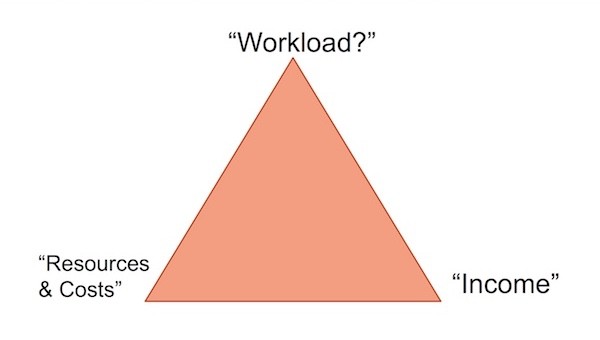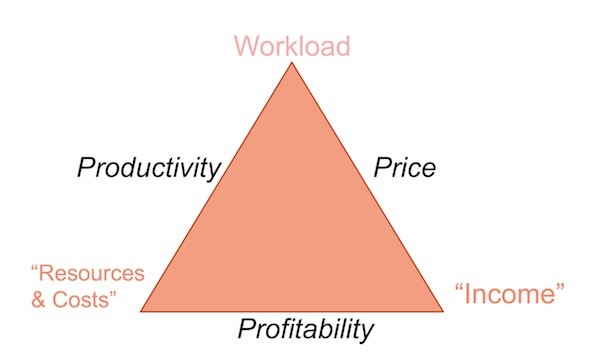We have talked and written many times about the importance of the scope of work in regard to setting or benchmarking agency remuneration based on productivity and not simply the cost of resources. But there is often confusion in regard to what is meant by a Scope of Work.
The most common confusion is that the Scope of Work is the same as the Scope of Services or Schedule of Services found in most agency contracts. But there are fundamental differences between a Scope of Service and a Scope of Work for the agency.
The confusion is increased when you consider a Schedule of Work, which is very different to a Scope of Services or Schedule of Services in that it provides the Scope of Work against a timeline, which allows the agency and advertiser to plan workflow and resources required. We have discussed the difference between a Scope of Work and a Schedule of Work here, so we will not spend too much time distinguishing these.
Scope of Services
In many agency contracts, there is a section, usually in the contract schedules and often referred to as the Schedule of Services, where the advertiser lists the services to be provided by the advertising agency. These services can be as broad or as specific as required and effectively define the role and responsibility of the agency.
These services may include:
- Provide strategic development of communication ideas.
- Participate in annual communications planning processes.
- Develop creative concepts to brief.
- Produce multichannel campaigns, including television, radio, cinema, digital and other media-specific communications campaigns.
- Provide account management to manage projects and day-to-day relationships.
- Provide estimates and invoices for work delivered.
- Manage agency resources to deliver required outputs.
This list can be as short as a dozen services and, in one case, was more than ten pages of services down to providing meeting and conference call reports after every contact and even how to manage the weekly work in progress.
Some of these schedules or scopes of services border on becoming service level agreements (SLA) with the addition of specific measures on service expectations.
e.g. Return calls and emails within 2 hours 99.5% of the time (This is one of my favourites as I love to consider who is measuring the phone call and email response rate from the agency to ensure it never drops below 99.5%)
Of course, some can confuse SLAs because they have a quantification and specificity that you see in a Scope of Work document. But service scopes and schedules do not provide what a good Scope of Work provides, which is the specific quantities of work and the type of work to be produced.
Workload, Income and Resource Cost

In setting up any meaningful agency remuneration model, you need to consider more than just the amount you pay and the cost of the resources the agency will provide.
Yet many retainer agreements are based on only these two metrics, with the negotiation based on the number of agency resources (measured as full-time equivalents or FTEs) and the associated cost (the salary or equivalent plus the overhead factor and the agency profit margin).
The lack of workload in this equation means there is no way of knowing if the level and cost of agency resources are appropriate or not.
INCOME = RESOURCE COST X OVERHEAD FACTOR X PROFIT MARGIN
This lack of a specifically defined agency workload is why so many agency remuneration agreements either end in the agency complaining about the over-utilisation of their resource, usually with their time sheets as the only proof.
Or, you have marketers complaining about a fall in agency quality in service and output as the agency substitutes more expensive agency staff for lower-cost agency resources to increase the number of hours the client gets for their retainer while maintaining the agency margin.
RESOURCE COST = PRO RATA STAFF SALARIES + ON-COSTS + OVERHEAD COSTS
If you look up the Scope or Schedule of Services, this does not provide the workload for the agency. Instead, it is simply a list of services to be provided by the agency under the agreement. Still, there is no indication of the quantity of these services that will be required that provides the ability to measure workload.
WORKLOAD = ∑ OUTPUTS OR DELIVERABLES BY AGENCY RESOURCES
Scope of Work
A properly structured Scope of Work provides the detailed information needed to define the agency workload. The workload provides not just the services to be provided by the agency in a given period (usually 12 months) but, more importantly, the number of deliverables those services produce.
This would include the number of campaigns or activities (e.g. brand, product, tactical, acquisition, retention, etc.) and the channels or types of outputs (e.g. television 30-second, 15-second cut downs, YouTube pre-rolls, 10-second billboards etc.) and even down to the number of originations and extensions or refreshes and adaptations (e.g. Facebook & Instagram Carousel, Canvases, Lead Ads five original, four refreshes and adaptations across formats).
Origination, Extension or Adaptation?
Originations: A new communications strategy and a new creative idea are required to create or originate new creative assets.
Extensions: Where an existing communications strategy and creative idea are being used to extend a new set of creative assets.
Adaptations: Where an existing communications strategy, creative idea and existing creative assets are being adapted to produce additional creative assets.
The more specific detail on the amount and type of outputs required, the more accurately one can calculate the number, mix, level and type of resources required to deliver the workload.
Using the Verificom Scope and Resource Calculator, we can accurately calculate the agency resources required based on the specific Scope of Work or workload. Knowing the resources and the cost of those resources then allows us to calculate the income required to be paid to the agency for them to deliver the workload and maintain the agreed margin.
The best approach for marketers and their agencies is to agree on a Scope of Work upfront. That scope of work goes beyond a list of services to be provided to detail the specific and measurable outputs or deliverables required.
While many marketers are worried about being too specific, as they know the Scope of Work will change, the fact is that without it, the ability to manage agency resources, cost and ultimately value is difficult. Instead, many will avoid providing a measurable scope and effectively request work from the agency until the agency resources run out and the agency is complaining of loss of profit.
Price, Productivity and Profit
By knowing the agency workload, income and resource cost, we can set a price for that work, measure their productivity and maintain a fair and agreed profit.

In the case of an existing remuneration agreement, being able to calculate or assess the productivity of the relationship can be incredibly valuable. By measuring the workload produced, either from the existing scope of work or capturing the actual workload delivered from the agency, you can then use the Verificom Scope and Resource Calculator to calculate the resources required and compare the two.
It identifies potential inefficiencies if the actual is higher than the calculated resource requirement.
PRODUCTIVITY = WORKLOAD / RESOURCES
Most marketers and procurement teams are happy for their agencies and suppliers to make a fair profit, even if what is ‘fair’ is often disputed. The problem is that when the workload increases through Scope of Work changes, the resource cost increases without a corresponding increase in agency income, effectively wiping out any agency profit.
Scope creep is virtually impossible to measure if the Scope of Work is poorly defined, making it one of the biggest issues facing the industry sustainability.
AGENCY PROFIT = INCOME – RESOURCE COSTS
Most current agency remuneration models are cost-based, taking the cost of the resources, adding the overhead cost, and then the profit margin. One issue with this is that there is no incentive for the agency to be more efficient.
If the agency is more efficient, then they use fewer hours and so are paid less. But another way of looking at this is as value pricing. If you move to a price model, you can calculate a price based on the outputs delivered against income. This means the amount paid to the agency is not based on the cost of the resources but on the price or value of the output of deliverable of the work.
PRICE = INCOME / WORKLOAD
Scope of Work Management
To manage your agencies more effectively and efficiently, you need to develop a Scope of Work. Beyond just a list of services, this allows you to not only accurately calculate the agency resource requirements using the Verificom Scope and Resource Calculator, it means you can determine the efficiency of your agency relationship by measuring productivity.
You can also use it to manage and adjust changes in the Scope of Work to avoid having the agency cry foul when they tell you you’re not paying enough. Finally, it can allow you to build productive and high-performing relationships built on mutual trust and fair and sustainable agency remuneration.
To find out more about the Verificom Scope and Resource Calculator and the Scope of Work Management services we offer click here





